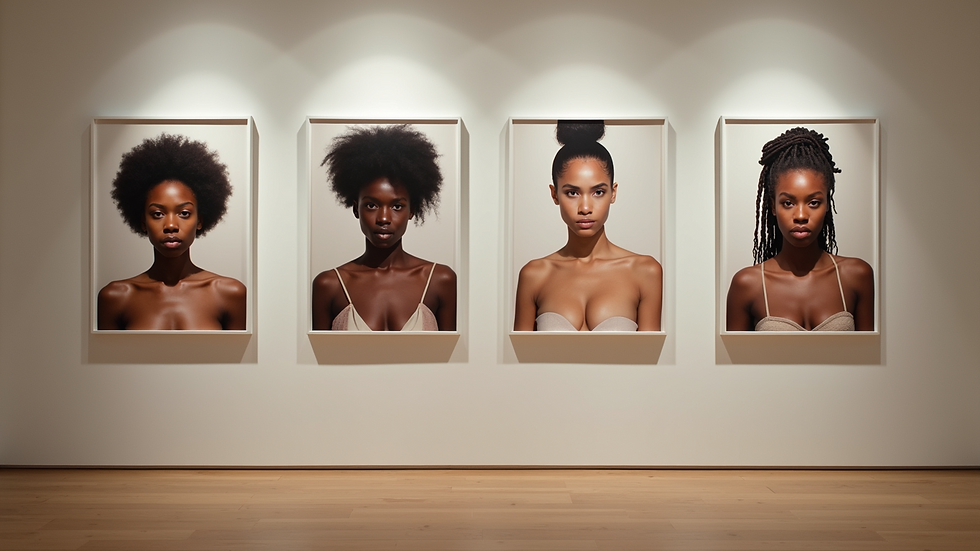Celebrating Underrepresented Bodies in Art
- Lesley Stedmon
- 3 days ago
- 4 min read
Art has long been a mirror reflecting society’s values, ideals, and biases. Yet, for centuries, many bodies have been excluded or misrepresented in mainstream art. This exclusion shapes how people see themselves and others, often reinforcing narrow standards of beauty and identity. Today, more artists, curators, and audiences are challenging these limits by celebrating underrepresented bodies in art. This shift not only enriches the art world but also promotes inclusion and understanding in society.
Why Representation Matters in Art
Representation in art goes beyond aesthetics. It influences cultural narratives and personal identity. When certain bodies are absent or portrayed through stereotypes, it sends a message about who belongs and who is valued. This affects self-esteem, social inclusion, and access to opportunities.
Visibility builds validation: Seeing diverse bodies in art affirms the existence and worth of those identities.
Challenges stereotypes: Art can dismantle harmful myths by showing complexity and humanity.
Expands cultural understanding: Diverse representations invite viewers to learn about different experiences and perspectives.
For example, the lack of disabled bodies in classical art often erased their presence from cultural memory. Contemporary artists who include disability in their work help shift this narrative, showing strength, beauty, and diversity beyond traditional norms.
Historical Exclusion and Its Impact
Historically, art institutions favored idealized bodies that fit dominant cultural standards—often white, able-bodied, cisgender, and thin. This exclusion was not accidental but tied to social hierarchies and power structures.
Classical art often celebrated mythic figures with ideal proportions, sidelining real bodies that did not fit these ideals.
Colonial art frequently depicted non-European bodies through exoticizing or dehumanizing lenses.
Modern art movements sometimes challenged norms but still largely ignored many marginalized identities.
This history means many people grew up without seeing themselves reflected in art, which can affect how they relate to culture and creativity. It also limits the art world’s richness by excluding diverse stories and aesthetics.
Contemporary Artists Who Celebrate Diverse Bodies
Today, many artists actively center underrepresented bodies in their work. Their art challenges norms and invites new conversations.
Zanele Muholi is a South African photographer who documents Black LGBTQ+ communities, focusing on visibility and dignity.
Cindy Sherman uses self-portraiture to explore identity, often challenging traditional beauty standards.
Tatyana Fazlalizadeh creates public murals that confront street harassment and celebrate women’s experiences.
Hank Willis Thomas addresses race and identity through photography and mixed media, highlighting overlooked narratives.
These artists use various media to show bodies that have been marginalized, from different races and genders to abilities and ages. Their work encourages viewers to rethink assumptions and appreciate diversity.
How Museums and Galleries Are Changing
Institutions are also evolving to include more diverse bodies and stories. This shift involves:
Expanding collections to include artists from underrepresented groups.
Curating exhibitions that focus on diverse identities and experiences.
Engaging communities to ensure representation is authentic and respectful.
Providing platforms for emerging artists who challenge traditional norms.
For example, the Tate Modern in London has hosted exhibitions highlighting queer artists and artists of color. The Smithsonian American Art Museum launched initiatives to collect and display works by disabled artists. These efforts help reshape public understanding of art and identity.
The Role of Audience and Collectors
Audience interest and collector support play a crucial role in sustaining diverse art. When people seek out and value art that celebrates underrepresented bodies, it encourages artists and institutions to continue this work.
Attend exhibitions featuring diverse artists.
Support galleries and museums committed to inclusion.
Purchase art from underrepresented creators.
Share and discuss diverse art on social platforms and in communities.
By actively engaging, audiences help create a more inclusive art ecosystem that reflects the full range of human experience.

Practical Ways to Celebrate Underrepresented Bodies in Art
Anyone can contribute to celebrating diverse bodies in art. Here are some practical steps:
Explore diverse artists: Seek out artists from different backgrounds and identities.
Educate yourself: Learn about the history of representation and exclusion in art.
Support inclusive spaces: Visit museums and galleries that prioritize diversity.
Create inclusive art: If you are an artist, consider how your work can reflect a range of bodies and experiences.
Advocate for change: Encourage institutions to diversify their collections and programming.
These actions help build a culture where all bodies are seen, valued, and celebrated.
The Impact Beyond Art
Celebrating underrepresented bodies in art has effects beyond galleries. It influences social attitudes, policy, and personal well-being.
Promotes empathy and understanding by exposing people to different lived experiences.
Challenges discrimination by normalizing diverse bodies and identities.
Supports mental health by validating identities and reducing stigma.
Inspires creativity by broadening the range of stories and aesthetics.
Art becomes a tool for social change, helping build a more inclusive and just society.
Celebrating underrepresented bodies in art is a vital step toward a richer, more inclusive culture. By recognizing and valuing diverse identities, artists, institutions, and audiences can reshape how we see ourselves and each other. This ongoing effort invites everyone to participate in creating art that reflects the full spectrum of human experience. The next time you visit a gallery or explore art online, look for the stories and bodies that have been overlooked—and celebrate their presence.




Comments